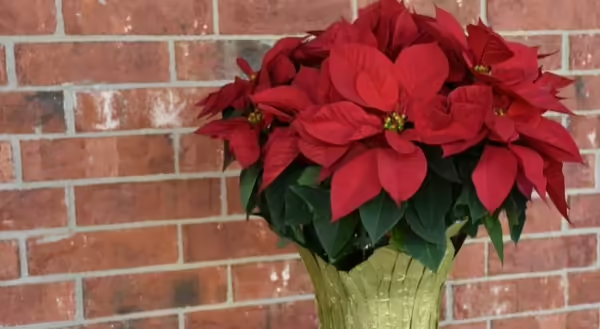
With an estimated 35 million Poinsettias sold annually, you may spot this colorful plant on many holiday tables every year.
Native to Mexico, Poinsettias are large perennial shrubs growing over 12 feet tall. Introduced to the United States in the early 1800s, it has become one of the most popular blooming houseplants to celebrate the holidays.
Although red and green leaves are common for Poinsettias, there are over 100 varieties available. You can find them in a range of bloom colors, shapes, and sizes. New trends in the market include marbled, speckled, and dyed Poinsettias—even blue!
Did you know the colored part of the Poinsettia is not a flower?
They are bracts, or modified leaves, that change color with shorter days and longer nights. Poinsettias require at least twelve hours of darkness for eight to twelve weeks before the bracts change color. The little yellow buds at the base of the bracts are the true flowers on the plant.
Even though Poinsettias are stunning additions to our holiday decor, some caution is needed if you have them around the house.
The foliage and stem contain a milky sap that may irritate the skin, especially for those with a latex allergy. It can also cause mild irritation or nausea in pets, if consumed.
If you wish to enjoy your Poinsettia for weeks beyond the holiday season, provide your plant with an ideal growing environment using these simple tips:
-
Provide bright, indirect sunlight.
- Avoid areas with a draft (cold or warm) like windows, doors, or vents. Plants need at least six hours of sunlight per day.
-
Display in a cool room for the longest life.
- The ideal indoor temperature is 60 – 70 degrees Fahrenheit during the day and 55 degrees Fahrenheit at night. Warmer indoor temperatures will cause the plant to decline sooner.
-
Water the soil surface when it feels dry.
- Check soil moisture by inserting a finger 1-inch deep into the soil. With too much, or not enough water, plant leaves will turn yellow and drop from the plant. If plants are in a decorative foil wrap, temporarily remove the wrap to let excess water drain from the plant base. Poinsettia roots easily rot if they are oversaturated with water, but the plant will wilt from a lack of water.
-
Protect the plant while outside...
- ...if transporting for holiday gatherings, and limit the time it sits in a car. Poinsettias do not tolerate cold temperatures. Cold temperatures for just a few minutes can damage the foliage and cause leaf drop.
If your Poinsettia lives into early 2023, you have provided well for your plant.
With quality care, many plants will only live six to eight weeks. However, many varieties can be kept as houseplants year-round by following the simple holiday care tips, with the addition of a balanced fertilizer once a month. To learn more on re-blooming care for winter 2023, check out university-related resources.
Enjoy this holiday season by spending time with family and friends, and of course, caring for your dear Poinsettia plant.
Photo Credit: Poinsettia by Ray Shrewsberry on Unsplash
ABOUT THE AUTHOR: Brittnay Haag is a Horticulture Educator with University of Illinois Extension, serving Livingston, McLean, and Woodford Counties. Her work focuses on youth horticulture education, specifically through school gardens and Jr. Master Gardener programs. Brittnay provides leadership for three county Master Gardener programs and is responsible for developing community programs and providing expertise in horticulture and environmental sciences.